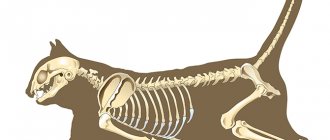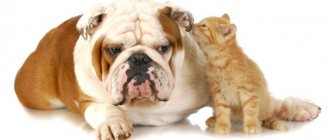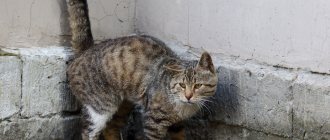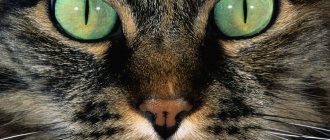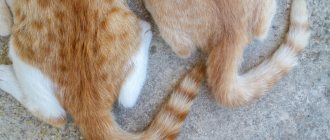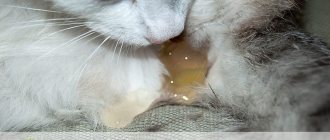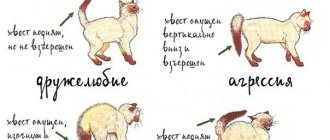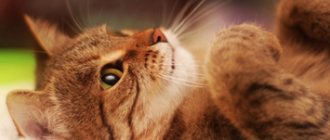Cats and dogs have their own individual characteristics and character. Cats, especially, strive to express themselves by imitating humans. To do this, they have many possibilities - ears, eyes, paws, mustaches and of course the tail. You can understand the language of cats by familiarizing yourself in detail and studying the signals that the pet tries to convey to its owner.
How to understand a cat's language by looking at its tail
In the course of research conducted by scientists from different countries, it became known that cats are capable of making over 60 different sounds. Thus, cats can vibrate in a variety of ways and also express their emotional state through body language.
The most powerful pointer in cats is the tail. Unlike a dog, a cat's tail is much more mobile and serves as a kind of balancer.
In addition, the tail of cats is an indicator of mood. A sharply raised tail, pointing straight upward, means great enthusiasm, greeting and expression of joy. Such a signal can be intended not only for the owner who has returned from work, but also for his relatives whom the cat has met on the street. The greeting involves not only the tail, but also the bend of the body and a soft purr.
The following states of a cat can be determined by the tail:
- A drooping tail means the cat feels frightened or slightly displeased. In such cases, it is better to leave the animal alone.
- Twitching of the tail or sharp swings indicate a degree of nervousness. The cat wants to be alone and it’s best not to disturb it. In this case, the animal does not intend to enter into a discussion with its owner.
- Twitching the tip of the tail is a manifestation of strong concern. The animal understands human speech and may show dissatisfaction about this if it hears unflattering reviews about itself.
- The raised hair on the tail is a sign of intense rage and undisguised anger. The cat is preparing to attack.
- A tucked tail between the hind legs is a feeling of fear.
Why does a cat wag its tail? And 9 more cat tail signals
We truly love our pets. For us, they are full-fledged family members with their own desires and needs. It's no wonder we often humanize them. But this can become a problem. By giving cats our own feelings, reactions and behavior patterns, we misread their habits and move away from them.
A responsible owner needs to remember that cats have their own motives for everything. It is important to learn to identify them correctly in order to avoid mistakes in parenting and not to lose that very connection with your pet.
The tail is one of the main clues, a guide to the world of mutual understanding with your pet. We know that a dog wags its tail when it is happy. But with cats it's more complicated. The position of the tail, its tension and bend, active movements or slight vibration of the tip - all these are signals that unmistakably reveal the mood of the pet. How to read them?
Learning to translate from cat language
- The cat holds its tail like a pistol.
If the cat's tail points confidently upward, this is a good sign. Your pet is in a great mood, she feels great and is open to communication and fun games. Only forward!
- Tail with a question.
A cat can curl its tail in such a way that it looks like a question mark. If you see such a tail on your pet, it means that she is friendly and quite possibly wants you to scratch her behind the ear. Sit your pet on your lap or invite her to play with the teaser.
- Vibrating tail.
Is your cat's tail up and vibrating? Attention: your cat is worried, but this excitement is positive. Typically, cats behave this way while they are being given a new portion of their favorite food or when the owner unpacks a fragrant treat. In a word, when they are anticipating something very, very pleasant.
- Tail hanging down.
If a cat's tail is tense and lowered, it means she is worried about something. Something that is happening makes her anxious and alarmed. Perhaps the cat smelled the scent of a neighbor's dog coming from the entrance. Or maybe she doesn't like your new perfume.
- The cat wags its tail.
If your cat hits her sides with her tail, don't think she's happy like your friend's cheerful corgi. On the contrary: she is very tense and perhaps even angry. This is how cats often react to new animals in the house, people they don’t like, or a hated vacuum cleaner.
- Swinging the tail up and down.
A cat can wag its tail not only left and right, but also up and down. If your cat does this, you should leave it alone. She's stressed or scared, and the best thing to do now is to keep her away from stressors and redirect her attention to something pleasant.
- The cat fluffed its tail.
Has the cat fluffed up its tail so much that it looks like a betta fish? And in addition, she arched her back and flattened her ears? This is a reason to be wary.
Your cat is very angry and ready to attack. Another scenario: she, on the contrary, is scared and is going to defend her territory, because there is nothing else left for her (in her opinion, of course).
In such a situation, the cat really needs your help. But don’t rush to pick her up: she may behave aggressively. Try to eliminate the irritating factor and distract the cat's attention, let her calm down and fully recover. And only after that you can try to caress your pet.
- The tail is lowered and tucked between the hind legs.
Attention, this is an SOS signal. Your cat is very stressed and is ready to fall through the ground from fear. If you have never noticed such a condition in your pet, you can be happy for him! But if this reaction is familiar to you, try to reconsider the conditions under which the cat is kept. This type of stress is not good for anyone!
- Lazy tail wagging.
A cat may wag its tail slowly and lazily. Perhaps at this time your pet is lying on a cozy bed or inspecting her possessions from a high shelf. Rest assured: the cat is thinking about some problem and looking for solutions. Maybe she saw you hiding a new delicacy in the closet and is making a plan to extort it?
- If the tail “hugs” the cat.
If the cat lies quietly and seems to hug itself with its tail along the contour of its body, try not to disturb it. Everything is fine with your pet: she is calm, cozy, warm. She is resting and gaining strength.
We wish your pet to give out as many positive signals as possible. Enjoy them - it's your fault!
Communication using limbs
If a pet gently moves its furry paws and at the same time releases its claws, then the animal is content and in a state of complete peace. Being in a good mood and feeling bliss, cats begin to mentally return to their early years. As a small kitten, the animal sucked its mother's milk and kneaded her belly with its paws. In addition to moving its paws, the cat begins to purr gently and soothingly.
Note! In such moments of bliss, the cat can forget itself and begin to release its claws, digging into the owner’s body. It is not recommended to scold or sharply pull your pet, as this can greatly offend an impressionable animal. It is best to carefully move the cat and pet it.
Very often, cats show their love for their owner by gently hugging them with their paws. But if the paw is raised sharply upward, with its claws extended, it means that the cat is preparing to defend itself and is determined.
Expressing emotions using ears and eyes
Cats' ears are excellent radars, designed to detect various sound waves. It is noteworthy that a cat in a state of wakefulness can detect the sound made by rodents at a distance of more than 20 meters. In search of a sound source, a cat can rotate its ear 180 degrees. More than 30 different muscles are involved in the ear's unique ability to bend, press, and rotate.
There are a number of emotions expressed through the position of the ears:
- A cat can express a good mood and positive attitude using its ears. In this case, they will be strictly in front at the top of the head.
- The placement of the ears in different directions or flat means that the cat is at a loss, not understanding what is happening.
- Dropped or pinned ears are a signal to attack; the pet is ready to defend itself and it is better to leave it alone.
- Ears turned and pressed back are a sign of rage and anger.
- Twitching ears means that the cat is nervous and irritated. This movement is often observed when the pet is watching a potential victim.
It’s not just a cat’s ears that can indicate the animal’s mood. The visual organ – the eyes, like people’s – can express a whole range of emotions. When a pet looks with an open, calm gaze, it means that she is happy with everything or is interested in the action taking place. There is an opinion among breeders and cat lovers that with the help of a look a cat can express its love for its owner. In this case, the animal looks straight into the eyes of its owner for a long time and devotedly, and then slowly closes its eyes.
Eyes
A person's eyes are the mirror of the soul. For a cat, things are a little different, but they can still tell you something. Wide, rounded pupils of a cat indicate severe fear, and much less often - surprise. If a cat you are unfamiliar with reacts to you in this way, it needs time to get used to the presence of a stranger, and it is better to leave it alone for a while. If, on the contrary, the pupils became very narrow, she was up to something. Most likely, she is angry and perhaps seeks revenge on the offender.
How to understand a cat by meowing
By meowing you can understand the whole spectrum of emotions felt by a cat. Cats express most of their emotions through gestures or facial expressions. Cats use sounds to emphasize their state or the emotions they are experiencing. In most cases, cats purr. This is a special sound created not by all vocal cords, but by vibrations in the upper register. The main purpose of purring is to express peace and love for the owner.
Note! Some owners note that the cat begins to purr, expressing its dissatisfaction or resentment.
A cat can not only purr, but also hiss, howl, chirp and make crackling sounds.
- Short cooing-like sounds are made by cats after a hearty meal, as well as while being stroked by their owner or in anticipation of a treat.
- Hissing means that the animal does not want to make contact, is very frightened and is ready to attack.
- howl and grumble during the onset of hunting. The animal shows its condition and calls the opposite sex.
- By meowing in high notes , a cat or cat is trying to attract its owner or a stranger.
- Specific sounds of chirping and crackling can be made by cats calling their grown kittens.
- But when a cat purrs with its mouth closed , it means full readiness for procreation.
Cats can produce many different sounds, differing in pitch, length and sound timbre. They are all different, but in most cases, loud sounds emitted express negative emotions, while soft and quiet ones indicate good spirits and mood.
If the animal begins to scream, making heartbreaking sounds, then this indicates that the cat requires help. Perhaps something hurts her. In addition, sharp, intense sounds made by an animal indicate a feeling of fear or anger.
Who needs a tail more: cats or dogs?
“The most important thing is that in cats and dogs everything is structured differently, usually in a polar way. Therefore, we cannot interpret the actions of cats and dogs in the same way,” explains the expert. According to her, cats' nervous systems are designed in such a way that the tail is much more important for them than for dogs. “Dogs are often docked. This is done less often now, but many breeds used to have their tails docked. And this did not bother the animals at all. If a cat’s tail is docked or she loses it for some other reason, this affects her more strongly. For example, it will be difficult for her to balance: for a cat, the tail is like a rod for a tightrope walker, it helps to maintain balance. Therefore, if cats, especially street cats, lose their tails, it will be difficult for them in the future,” says Sirotina.
Question answer
Do pets have blood types?
According to the expert, when a cat is unhappy with something, is irritated by something, or is not in the mood and does not want to interact with a person, it begins to move its tail vigorously: the movements will have a large amplitude, the cat will jerk its tail from side to side or “ wag" them. However, the “tail tongue” may differ between breeds. “In some breeds of cats, for example, Abyssinians, the “vibrating” shaking of the tail may, on the contrary, indicate a favorable mood of the animal,” explains the expert. Sphynxes and other companion cats that seek to be in human company use their tail to express their joy and willingness to communicate. It usually looks like this: the animal raises its tail vertically and begins to shake it finely. “When such cats see a person, they rejoice: they begin to move their paws and make such a characteristic movement of their tail. This is how the cat expresses its disposition: it can’t wait to interact with a person,” says Sirotina.
Which countries love cats the most? Infographics Read more
Cat sign language
Cats and kittens can express their attitude and emotional state not only with the help of their ears and voice. With the help of body language, cats can show their friendly attitude, humility, peace, arrogance, resentment and other emotions.
Having shouted or offended his pet in some other way, a person notices that the cat turns its whole body in the opposite direction from him, not paying attention to calls and appeals. Experts say that this is not so much an indicator of arrogance and arrogance as a fear of meeting the eyes of an angry owner.
When a cat shows its belly , it is a signal of a friendly attitude and a special degree of trust. The animal is in a good, playful mood and will, with great pleasure, allow itself to be stroked and cuddled.
In cases where a cat arches its back and raises the hair on its nape and tail, we can confidently say that the animal is ready for an attack and a fierce battle. On the contrary, if the pet tries to hug the floor, bend its ears and tail in order to appear visually smaller, it means that the cat does not intend to communicate and wants to be left alone.
Cat's eye language
In communication between people, views play a fundamental role. Cats can also “tell” a lot with their eyes. There are several options in cat language:
- wide open eyes, gaze;
- squinted eyes;
- slow blinking.
If the cat's eyes are wide open, this is a gesture that should frighten the enemy. The pet uses such a “weapon” if there is a fight with another cat, or if he is going to attack a person or another animal. A pet can open its eyes wide when it is interested in something and carefully studies the object.
When a feeling of complete trust appears, cats close their eyes. She is not afraid of anything, she is impressed by the person or animal nearby. Slow blinking also indicates pleasant emotions; it can be observed when a cat purrs.
Lovers of these pets know that if there are several people in the room, there is a high probability that the cat will approach someone who is unkind to animals. The fact is that direct gaze is perceived as a threat. People who love cats will certainly look at the pet. And a person who has a negative attitude towards these animals looks away. The cat believes that he is the safe object.
Communication by smells
At first glance, it may seem that we are talking about marking territorial boundaries. But this is not entirely true, because there is also a secret type of communication between a pet and its owner using smells.
The most important aromas with which a cat establishes contact with its owner are the elusive odors left by the animal on a person with the help of specific glands located on the chin, forehead and lips.
These glands produce special odors used for greeting (a cat pokes its face after a long absence of its beloved owner). Cats often rub against the owner’s legs, leaving as much odor as possible on the owner’s clothes, and they also rub their muzzle into the person’s face and hands in order to leave more odor on the skin.
After such secret manipulations, a person receives a whole spectrum of specific odors that accompanies him everywhere. Cats believe that the owner also marked them when he stroked their fur or head, leaving their scent in return as a sign of devotion and love.

